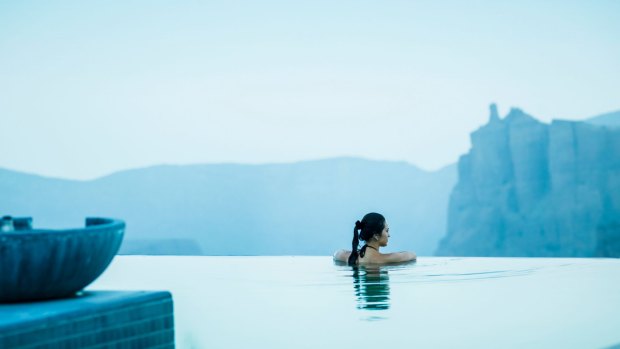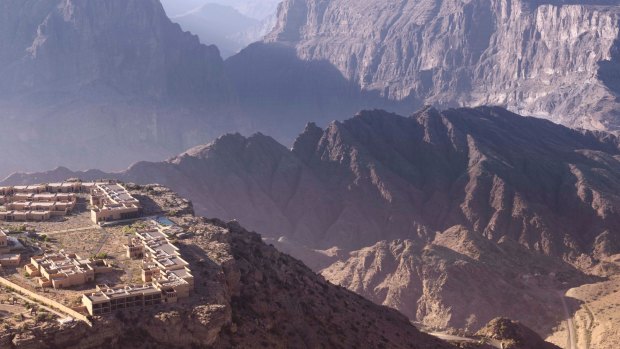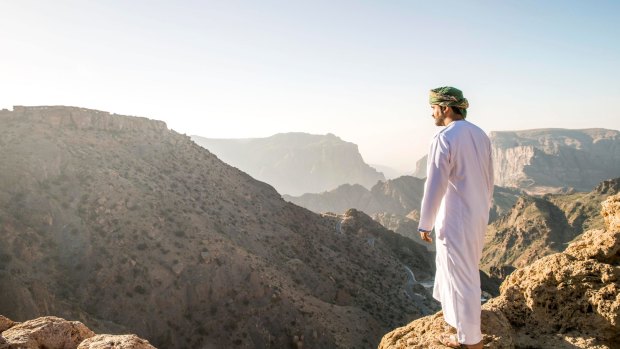By Daniel Scott

Infinity pool Anantara Al Jabal Al Akhdar Resort.Credit: Paul Thuysbaert
*** 1. VISIT – THE GRAND MOSQUE, MUSCAT
The Grand Mosque, gifted to the Omani people by Sultan Al Qaboos Bin Said-Al-Said to commemorate his long reign, is one of few buildings on earth to earn the description "breathtaking". Opened in 2001, it is built from 300,000 tonnes of Indian sandstone and accommodates 20,000 worshippers, with 7500 packed into its main prayer hall. The domed hall is adorned with a 70 by 60 square-metre carpet, featuring 1.7 million stitches, and a 15-metre-tall central chandelier weighing eight tonnes and comprising 600,000 Swarovski crystals. While the prayer hall awes, colonnaded passageways outside, reflecting different periods of Islamic influence, captivate with their intricate design. Open to non-Muslims 8.30-11am daily, except Fridays. See Sultanqaboosgrandmosque.com
2. SCENT – FRANKINCENSE

Anantara Al Jabal Al Akhdar Resort.Credit: Paul Thuysbaert
If ever an aroma could spirit you away to a different place then it is burning frankincense, its fruity perfume drawing you to the Arabian desert. Frankincense was the making of this Middle Eastern peninsula. Recognising its value – it was once worth as much as gold – Arab merchants established trade routes spanning from Rome to China, and included the Queen of Sheba among their customers as well as three wise men heading for Bethlehem. The planet's finest frankincense is sourced from boswellia trees in southern Oman, and were once defended, according to legend, by flying snakes. To learn more visit the Museum of Frankincense Land in Al Baleed archeological park, Salalah. See Whc.unesco.org/en/list/1010
***3. STAY – ANANTARA AL BALEED SALALAH
This brand new resort is set beside the Arabian sea and adjacent to the Al Baleed World Heritage site, drawing inspiration from the land of frankincense where it's situated, and from the region's coastal fortresses. Spread out like a village, its pathways are interspersed with 750 palm trees and water features mimicking Oman's ancient al falaj irrigation system. Guests in premier villas have in-ground pools, ocean or freshwater lagoon views and are welcomed with a sublime foot scrub, reflecting Anantara's Asian roots. The hotel spa also offers a 90-minute "frankincense ritual", delivered by two therapists, using the distinctive essence in the massage oil, scent burners and even an infused tea. See Salalah.anantara.com

Reflecting thousands of years as a maritime trading nation, Oman is one of the the most outward looking nations in the Middle East.
4. SHOP – MUTTRAH SOUK
Muscat's souk is an Aladdin's cave of small shops, behind and amid a strip of seaside restaurants and cafes, selling everything from curios to fabrics. It's a good place for women to find scarves and pashminas, men to be fitted with an Omani dishdasha robe or embroidered pillbox hat and to bargain over souvenirs. Best experienced after dark and followed with an Omani dinner upstairs at Bait Al Luban restaurant, overlooking the harbour. See Baitalluban.com
5. DIVE – GULF OF OMAN
About a 45-minute boat ride from Muscat lies the Daymaniyat Islands Nature Reserve, encompassing nine uninhabited islands and numerous dive sites. Diving here is mostly on coral reefs, where swathes of multicoloured hard and soft corals battle with crown of thorns starfish. The diving is best between May and September, with good visibility, balmy sea temperatures, and the possible company of large, harmless whale sharks, along with turtles and leopard sharks. See Adventureworld.com/oman
6. VISIT – NIZWA FORT
This formidable castle stands sentinel over the surrounding oasis and date plantations, at the foot of the Hajar mountains, in Oman's sixth and seventh century capital, Nizwa, 90 minutes drive from Muscat. Although some parts date to the ninth century, the distinctive 24-metre high round fort was built in the mid 17th century by Imam Sultan Bin Saif Al Y'aribi, who rid Oman of the occupying Portuguese. Topped by rounded-battlements, it includes gun emplacements, honey-traps and pitfalls among its defence mechanisms. Inside, in former jail cells, are interesting exhibitions on Omani history. See tourismoman.com.au/travel-experience/nizwa-mountains-muscat/
*** 7. TOUR – THE EMPTY QUARTER DESERT
The Rub Al Khali or Empty Quarter is the largest sand desert in the world, spanning 650,000 square kilometres and covering much of the Arabian peninsula, including large swathes of Oman, with some of its dunes reaching heights of 250 metres. Watching the sun set over the caramel coloured sands, from the peak of a dune, is quietly awing. Day and overnight trips, with a Bedouin guide, are available from Salalah via salalah.anantara.com. Adventureworld.com/oman have multi-day trips crossing the Empty Quarter from Salalah to Muscat.
8. EAT – ALLOOMIE RESTAURANT, MUSCAT
Opened in October 2016 as part of the ritzy Al Bustan Palace Hotel, but set in its own gardens, Alloomie is the sultanate's first Omani fine dining restaurant. The love child of chef Salim Al Kalbani and wife Amal, who plays mixes with diners, either at tables in the garden or in airconditioned "forts" or dine-in areas, Alloomie conjures the heart and soul of Omani cuisine. Try the "9 Flavours of Oman" tasting menu, including magain, a traditional snack of beef cubes with sesame bread and salsa; seared camel meat served in puff pastry and ryash, lamb chops marinated in Omani herbs, served with mashed potato and spicy carrot puree. See Alloomie.com
9. CLIMB – HAJAR MOUNTAINS
While Prince Charles and his young wife thought location of another new Omani Anantara hotel, on the rim of a canyon, 2000 metres above sea-level, was delightful for painting and reading, on a visit to "Diana's point" in 1986, the surroundings now include a 20-metre climbing wall and via ferrata clamped to the mountain side. Adventurous guests at the Anantara Al Jabal Al Akhdar begin on an indoor climbing wall, then put on harnesses and are secured to the via ferrata before edging backwards into the plunging canyon and abseiling down. If that's nerve-racking, the climb back up is a heart-pounding challenge. See Jabal-akhdar.anantara.com
10. STAY – MUSCAT HILLS HOTEL
This recently revamped former dive resort makes a pleasant, away-from-it-all alternative to Muscat's city hotels, with barasti-style style beach hut accommodation. Set behind languid Al Jissah bay, it summons up relaxation with its striped sun loungers and umbrellas, beachside shisha lounge and alfresco restaurant looking out to sea. For the more active, the resort still offers PADI recreational dive courses, centred initially on the pool, and kayaking in the turquoise bay. See Muscathilsresort.com
11.VISIT – NIZWA GOAT MARKET
You'll have to be up early to catch Nizwa's Friday morning goat market, which draws traders from across Oman. By 7am, it's already a cacophony of bleating animals and vigorous discussion, as owners parade their goats around a central pavilion and buyers look on. Watch the intent faces of men and boys and the eyes of women peering through their niqabs (face veils) to assess the form and you'll be drawn into ancient Oman. A cattle market follows and Nizwa souk is adjacent for souvenir shopping.
12. SEE - OMANI CAMEL RACES
Camels are a big a part of Oman's landscape, long used for transport, food and as "ships of the desert". What's less known is that these gangly creatures can reach speeds of 64 km/h, making camel racing popular on the Arabian peninsula. In Oman the season runs from September to April, with races across the country, with schedule information available from timesofoman.com. In the southern Dhofar region, there is also a camel beauty and milking festival, in Thumrait, August 13-18, 2017. See Omantourism.com
13. VISIT – THE ISLAMIC INFORMATION CENTRE
Oman is arguably the Middle East's most accessible Islamic nation, with a welcoming attitude to foreigners and most people happy to talk about their faith. Situated at Muscat's Grand Mosque, the Islamic information centre, is a valuable resource that encourages open discussion of Islam and the Muslim way of life. Spend time here with the friendly imams (lay worship leaders) and you'll emerge enlightened and better informed about a religion we know shockingly little about. See Iicoman.om
*** 14. STAY – ANANTARA AL JABAL AL AKHDAR
Another indication that Oman's tourism is evolving fast, the luxury Anantara Al Jabal Al Akhdar Hotel opened in October 2016, two hours from Muscat, in the Hajar mountains. This second new Anantara property is the highest five-star resort in the Middle East and enjoys dizzying views and year-round cooler temperatures. It's also a masterpiece of Omani architecture, with a fort-like structure, village-like interior and North African design details. Excellent food, in Omani and internationally themed restaurants, a range of adventurous activities connecting you to its mountain locale, an exceptional spa and strong service complete the picture of an exciting new hotel. See Jabal-akhdar.anantara.com
15. EAT – OMANI STREET FOOD
Street food is expanding beyond traditional falafel and shawarma (chicken, lamb or beef with tahini, lettuce and mayonnaise) sandwiches, wrapped in Arabic bread. Stalls selling delicious mishkak kebabs, with a choice of meat flavoured with tamarind sauce, are becoming popular at Muscat's beaches, as are Omani bread crepes, using crisp khubz rakhal bread and filled with cheese, honey or egg. Otherwise, visit a workers cafe behind Muscat's fishing port in Muttrah, and try fried fish with biryani rice.
16. VISIT – THE LOST CITY
While it has yet to be scientifically proven, the discovery of a lost city, swallowed up by the desert, at Shisr, in Oman's Dhofar region, in 1992, led to widespread speculation that it was the fabled "Atlantis of the sands", the ancient centre of the frankincense trade. Located 170-kilometres north of Salalah, at the edge of the Empty Quarter, the remains of the fourth century BC settlement form part of the Land of Frankincense World Heritage site also encompassing Al Baleed, the ancient port city. See whc.unesco.org/en/list/1010
***17. MEET – OMANI PEOPLE
Reflecting thousands of years as a maritime trading nation, Oman's small population of 3 million is among the most outward looking and welcoming in the Middle East. Among many influences were the occupying Portuguese and Ottoman Turks, Indians from across the Arabian Sea and the British, who supported the Sultanate during the civil war (1962-76). Omanis are mostly Arabic, although many speak Swahili, thanks to historical ties with Zanzibar, once an Omani overseas territory, and there are around 28,000 Bedouins, the nomadic desert people that beguiled travel writers such as Freya Stark and Wilfred Thesiger.
18. VISIT – NATIONAL MUSEUM, MUSCAT
The place to get the lowdown on Oman's history and culture, the museum has galleries reflecting "the land and the people" and the nation's seafaring and shipbuilding heritage, which dates back 4000 years. Other exhibits detail the importance of frankincense in Oman's past, sparking trade with the great civilisations, from Rome to Jerusalem to China, the advent of Islamism and the "renaissance" since Sultan Al Qaboos Bin Said-Al-Said came to power in the 1970s.See https://www.tourismoman.com.au/travel-info/arts-culture/
19. TREK – HAJAR MOUNTAIN VILLAGES
Take in three 700-year-old villages, Al Aqr, Al Ayn and Ash Shirayjah on a guided walk with an Omani "mountain guru" from the Anantara Al Jabal Al Akhdar. The villages still use the ancient falaj irrigation system to maintain hanging terraces chiselled from the cliffside, growing damask roses – for the local specialty rosewater – pomegranates, walnuts, pears and garlic. Follow the waterways to narrow alleyways in the half-deserted villages, where you visit a rosewater distillery and abandoned mosques and homes. See Jabal-akhdar.anantara.com
20. ATTEND – THE ROYAL OPERA HOUSE, MUSCAT
Oman's opera house is the first on the Arabian peninsula and according to director general Umberto Fanni, "epitomises the nation's vision, building bridges to connect with other nations, other communities". Completed in 2011, it's a dazzling Omani architectural statement and a top venue for opera and concerts, holding 1100 spectators. Among those to have performed at the Opera House are Andrea Bocellli and, Placido Domingo. See Rohmuscat.org.om
The writer was a guest of Oman Tourism and Anantara.
TRAVELLER'S TOP FOUR
· The Empty Quarter
· The Grand Mosque
· The two new Anantara properties
· Omani people
Sign up for the Traveller Deals newsletter
Get exclusive travel deals delivered straight to your inbox. Sign up now.